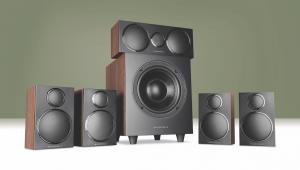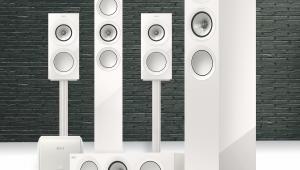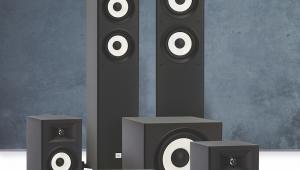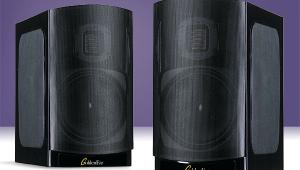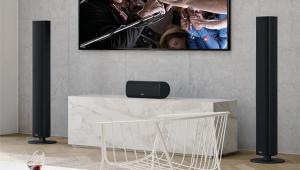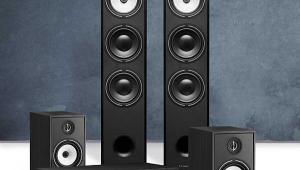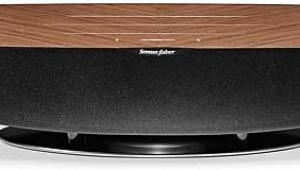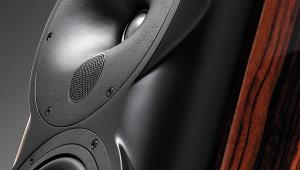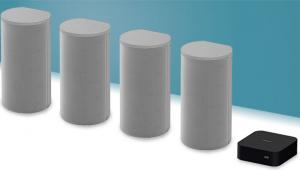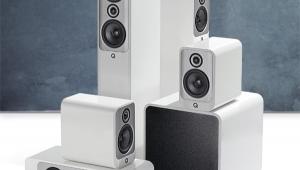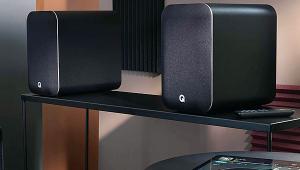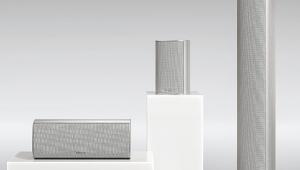Revel Concerta On Wall Series loudspeaker review
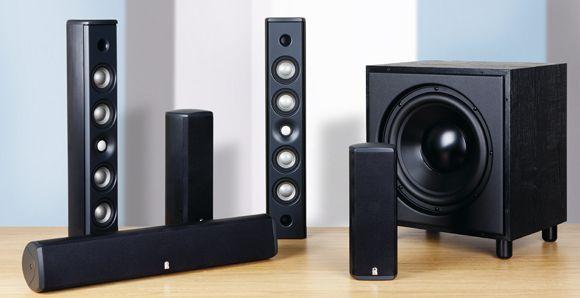
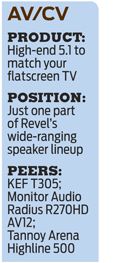 People in the home cinema industry – manufacturers, PRs and the like – know me for being keen on mad, huge potent audio. Giant 18in subwoofers and speakers the size of Stonehenge. I think they sometimes forget that I am also impressed by the delicate and the clever. So much so, that with this set of skinny tower-style speakers, all housed in an aluminium toothpaste-tube squeezed-out extrusion, I could feel palpable fear from the PR chap as he kept on politely enquiring how I was ‘getting on’ with the Revel Concerta speaker system.
People in the home cinema industry – manufacturers, PRs and the like – know me for being keen on mad, huge potent audio. Giant 18in subwoofers and speakers the size of Stonehenge. I think they sometimes forget that I am also impressed by the delicate and the clever. So much so, that with this set of skinny tower-style speakers, all housed in an aluminium toothpaste-tube squeezed-out extrusion, I could feel palpable fear from the PR chap as he kept on politely enquiring how I was ‘getting on’ with the Revel Concerta speaker system.
Designed to be used on-wall, hence the OW (On Wall) name, they are sold with solid two-piece steel wall brackets that afford a thirty-degree slant up or down (or inwards) from the flat-to-the-wall bracket mounting plate. The centre also comes with a small, plastic injection-moulded stand for better aiming the output at the listeners.
I had the Concerta M10 left/rights, C10 centre and the M8 as rears. The front baffles and end pieces are a big piece of the story, and are all about housing the high-tech tweeters in small horn-like waveguides for improved dispersion – and, in the case of the left and right speakers, making sure they are at the right height for your ears. For as well as the full-length wall brackets, the M10 speakers are supplied with a triple-choice of heights from their stands. This is by use of one of the three pieces of threaded extrusion, also finished in the same sexy fine-brushed anodised black.
If you want your M10s to look like towers, then £200 a side will get you the STANDM10 product, which is a substantial base with a long section of the same extrusion and bolts that reach all the way through it, to secure the enclosure to the stand. There’s even an aluminium billet-turned locating peg to spanner into the stand, used to keep the union between the stand and the speaker utterly rigid.
Dressed to compressThe speaker drivers are improbably clever. Called MCC, or Micro Ceramic Composite, they use a deep anodised finish on both sides of an aluminium core and, just like Acoustic Energy, Revel knows this reduces power compression effects and sounds brilliant, as such a speaker cone acts as a rigid piston. This is especially vital as they are all but 3in wide, bar the smaller tweeter, which is made of the same stuff.
Amazingly, the tremendously cunning subwoofer has a whacking 12in driver in it that is also of the same ilk, and it works deep and rich and even. It also packs a built-in wireless receiver, so if you plug the optional sender unit in at the front end, you need not run a phono cable around to your woofer. This makes placement much easier, limiting you only to where your room’s plug sockets are.
There are two pairs of the stumpy 3in drivers in the M10 and C10, which is just the former on its side wearing its badge wonky. There are just two of these drivers in the shorter M8, yet both the specs for the M8 and the C10 and M10 claim they will play only -3dB at 110Hz, which is quite a thing to say.
The subwoofer has a single channel of parametric EQ fitted to it, or rather Parametric CUT, as there is no +/-, rather just up to a berserk 14dB of attenuation. You have to know what frequency and how widely to affect the frequencies around your chosen attenuation point (Q factor) to set it correctly. This can take a Real Time Analyser (RTA) or PC and a considerable amount of faffing around.
But I am an ex-live sound engineer and I have seen three different auto-EQ systems’ analysis of my living room. So, after a week of leaving the system simply chugging away a bit with my telly, I finally dived in and gave it some effort on the setting of the EQ, making a pretty fat cut around 63Hz by a good slice of -9dB, right in my problem zone.
Beefy bottom endAnd finally, I ‘got’ the system and realised Revel’s PR boy didn’t have a thing to worry about. Because, just like systems by the likes of Bose, this set by necessity has to use the weight of a well-tuned subwoofer to give some scale and mass to the whole sound, let alone the deep stuff. It’s an odd effect but is all about how subwoofers tighten your whole soundstage, not just the bottom end.
Up until I had bothered to tune the woofer, I hadn’t really got much of a good impression. But I now gave it some serious listening, and, under drive with some real wattage, those tiny wee aluminium midrange drivers and tweeters really came to life.
I put some music on first, multichannel and jazzy. The pock of a rimshot on a snare drum impressed, while the detail of a brushed cymbal sussurated in the rears. There were rich sweet reverberations and horns with a lovely dirty honky edge, the original reed and rasp coming through. It was unbelievable quality from 3in drivers. Like Formula One engines: low capacity but revving their nuts off to make massive power.
The subwoofer was immense in output. It had to work and pump with such vigour – no passive driver here – to just support the system, but did so without any telltale over-excited-cabinet wobbling. My EQ cut worked well, the rest could pump, and ultimately the speakers, skinny though they were, did that lovely thing when they disappear, the soundfield being all you care about. With Paul on Blu-ray [Again? - Ed] on my new Panasonic BD/HDD PVR, I was lost in the night-time desert opening sequence, marvelling at the crackle of a sucked-on cigarette.
Skinny winnersThe whole of the Revel Concerta On Wall system benefits from the lack of power compression inherent in the cone technology. You get a lovely sound, great accuracy and even some scale. You’ll need a strong amp to really drive them well, but if you’re hunting for speakers that don’t look like dogs’ coffins but still deliver the goods, then I recommend you check them out.
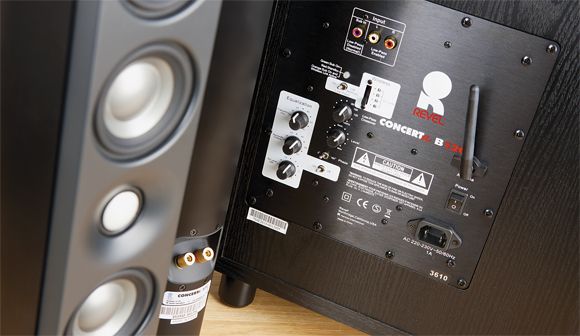
HCC VERDICT
Revel Concerta On Wall Series
Price: £3,400 Approx
Highs: Smooth powerful audio with great imagery; designed to match your flatscreen
Lows: Need to be run like thoroughbreds; sub requires a serious RTA for EQ setting
Performance: 4/5
Design: 4/5
Features: 4/5
Overall: 4/5
Specifications
Revel Concerta M10
Drive Units: 2 x 3in Micro Ceramic Composite (MCC) woofers; 2 x 3in MCC midrange drivers; 1 x 1in MCC dome tweeter housed in Constant Acoustic Impedance waveguide
Enclosure: Two-and-a-half-way with dual front-firing ports
Frequency Response: 110Hz-20kHz
Sensitivity: 89dB (2.83V @ 1m)
Power Handling: 150W
Dimensions: 107(w) x 582(h) x 113(d)mm
Weight: 3.1Kg
Revel Concerta C10
Drive Units: 2 x 3in Micro Ceramic Composite (MCC) woofers; 2 x 3in MCC midrange drivers; 1 x 1in MCC dome tweeter
Enclosure: Two-and-a-half-way with dual front-firing ports
Frequency Response: 110Hz-20kHz
Sensitivity: 89dB (2.83V @ 1m)
Power Handling: 150W
Dimensions: 582(w) x 107(h) x 113(d)mm
Weight: 3.1Kg
Revel Concerta M8
Drive Units: 2 x 3in MCC woofers; 1 x 1in MCC dome tweeter
Enclosure: Two -way, front ported
Frequency Response: 110Hz-20kHz
Sensitivity: 88dB (2.83V @ 1m)
Power Handling: 125W
Dimensions: 107(w) x 296(h) x 113(d)mm
Weight: 1.6Kg
Revel B120
Drive Unit: 1 x 12in MCC woofer
Enclosure: Down-firing, floor-loaded port with front-firing driver
Frequency Response: -3dB @36Hz (-6dB @ 32Hz) to crossover
On board power: 250W RMS
Dimensions: 400(w) x 450(h) x 356(d)mm
Weight: 23.2Kg
Connections: Phono input in stereo as well as single LFE phono socket
 |
Home Cinema Choice #351 is on sale now, featuring: Samsung S95D flagship OLED TV; Ascendo loudspeakers; Pioneer VSA-LX805 AV receiver; UST projector roundup; 2024’s summer movies; Conan 4K; and more
|




